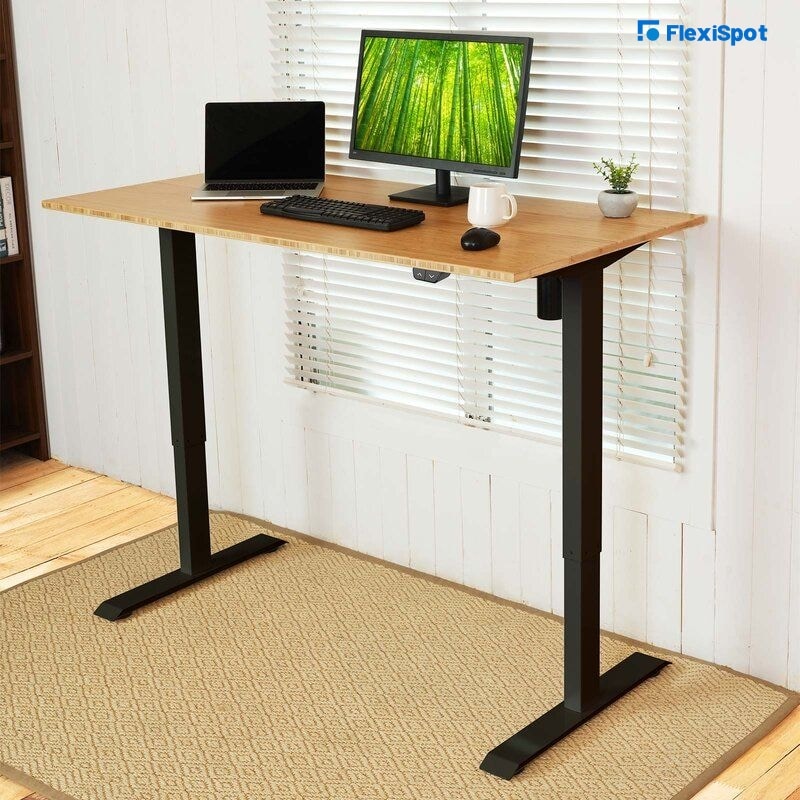As more individuals recognize how crucial it is to maintain the environment, eco-friendly measures are gaining traction. You may use these green methods in the office to build a healthy and ecologically friendly working environment. Smart initiatives may help the environment while simultaneously lowering your operational costs.
Making a green workplace isn't as difficult as you would assume. Regardless of whether you adopt one little action or complete the whole list, you'll reap the advantages of knowing you've created a more environmentally friendly workplace.
Use Environmentally Friendly Office Supplies
There are a few ways to adopt eco-friendly office supplies and workstations. Firstly, the furniture itself needs to be made of sustainable materials so that it isn't damaging to the planet. Choosing plastic or steel means that it will eventually end up in a landfill site. We recommend bamboo desks that can create a more sustainable workspace while adding natural tones to the office aesthetic too. If you get climate-positive bamboo standing desks, it can even elevate the health of your employees and doesn't damage the planet.
Upgrade to eco-friendly options instead of standard workplace mainstays in your supply cabinet. Everything from printer paper and sticky notes to toilet paper and Kleenex should be made of recycled paper. Choose biodegradable coffee and water cups, as well as 100% recyclable binders that don't contain the dangerous plastic found in other binders.
You may also make your company supplies more environmentally friendly by repurposing what you already have. Encourage workers to return discarded file folders to the storage room after they're completed so that others may repurpose them for new projects by changing the label. Remove any worn pages and discard any notepads or notebooks that are no more in use.
Avoid Printing That Isn't Essential
Many papers no longer need printing in today's digital workplace environment. Encourage your workers to print papers only when absolutely necessary. Instead, post announcements on a virtual bulletin board, send notes through email, and share documents over the cloud.
If you're having trouble reducing waste in this department, try using software that analyzes your print usage, makes recommendations for reducing waste, and provides better solutions whenever you request a print job. If a user still wants to print, the program will send the job to the least priced printer in the workplace.
Think Beyond the Box When It Comes to The Workplace
To be productive and effective in your field, you don't need a large office area. If you have idle offices, conference rooms, or large lobbies and open spaces that aren't being utilized, downsizing to a smaller location might save you money and reduce your carbon impact. Smaller workplaces need fewer utilities and upkeep.
If any of the employees work from home, you may discover that eliminating the physical office is the best solution. Enable freelancers to rent their own workstations or office, ensuring that space and resources are put to the greatest possible use. No matter where you work, each office is somewhat different, so you can pick one that matches your own work style.
Turn Off the Power to Your Energy Leeches
Energy leeches lurk in the corners of offices. Even when not in use, these objects slowly deplete energy. When computers are not in use, they may draw energy. If large equipment like printers and copy machines are never switched off, they may use energy 24 hours a day, seven days a week. Many kinds of devices may utilize energy even when they are turned off. Stopping the drain of energy at the power outlet is the only option.
Select smart power strips with a programmed timer that will switch off the strip every day when the workplace closes. Others detect the presence of people in the room and turn off devices when the workplace is empty. When one essential item on current-sensing power strips is turned off, the whole strip is turned off. When you turn off your computer, you may arrange this strip to turn off the electricity to everything at the desk. A smart power strip will save your electricity expenses while also making your workplace eco-friendlier.
Make Any Necessary Lighting Adjustments
In the workplace, you may not give lighting much thought, yet changing your lighting strategies may have a significant influence. If your workplace has huge windows, think about whether you really need lights on throughout the day. Although your lighting is likely to be on by design, you may discover that you can turn lights off throughout the day. You may also utilize ceiling lights for work lighting to avoid illuminating areas that aren't being used. For corridors, toilets, break rooms, as well as other locations that aren't utilized often, motion-activated light is a good solution.
Compact fluorescent bulbs (CFLs) or LED lights are the most environmentally friendly options for your workplace lighting. Check the bulbs and replace them as needed to make your workplace more environmentally friendly.
Reduce The Amount of Time You Spend Heating and Cooling
When was the last time you reprogrammed your thermostat? Reprogramming is one thing you should do at least 2 times a year in most climes. Keep the workplace a little warmer throughout the day during the summer months to save electricity. Increase the temperature during off-peak hours when the facility is unoccupied. In inhabited rooms, strategically positioned ceiling or desk fans provide a natural cooling effect. When the area is empty, remember to turn off the fans since they are only cool people who can feel the wind on their skin. Temperatures are not reduced by using fans.
Adjust the thermostat to keep your workplace somewhat cool throughout the cooler months when the facility is unoccupied. In the early autumn, schedule a furnace tune-up, and in the early spring, schedule an air conditioner tune-up. This tune-up will keep your HVAC system in excellent shape while consuming the least amount of energy feasible. For the cleanest air and optimum efficiency, have the maintenance staff or office manager replace the HVAC filters once every one to three months.
Purchase Food from A Local Suppliers
If your workplace provides a variety of snacks, switch to foods that are sourced locally and manufactured organically. If you buy your fruits from a local farmer's market, you'll get a great taste while also leaving a lower carbon imprint. See if you can collaborate with a restaurant that concentrates on local, eco-friendly foods if you operate a lunch cart or utilize a lunch delivery service. Breakfast sandwiches made with eggs from nearby farms or a lunchtime sub made with grass-fed meat from a local butcher.
These methods will not only provide healthier food for your staff when they are at the office, but they'll also connect them to local suppliers from whom they could choose to purchase during their free time. Inquire with a local farm about bringing their goods to the workplace a day every week so that the workers may purchase snacks and groceries to take home. These measures may help your community adopt more ecologically friendly living habits.
Eliminate The Use of Paper Towels
Are you using paper towels to wipe up mistakes in the kitchen and to dry your hands in the restroom? For hand drying, air dryers are really a better option. You may use eco-friendly paper towels manufactured from bamboo and sugarcane in the kitchen, for example. Request paper towel suggestions from your local office supply store.
Educate Your Workforce
Many green solutions place a strong emphasis on the actions of workers. Create a workplace training program that teaches your staff how to operate in an environmentally responsible manner. This training involves educating them on how to use paper mindfully and how to prevent energy drains from office products. If your business has a recycling program, ensure your staff knows how to utilize it properly. Encourage people to carpool, walk, or bike to work. Collaborate with local transport operators to give reduced bus tickets to your workers, encouraging them to use public transit more often.
While a conscious office manager may provide numerous possibilities to help a workplace become eco-friendlier, employee execution is the key. You may optimize the impact of your green workplace if your office personnel employ the installations and programs accessible to them.
Creating a sustainable workplace helps reduce your company's environmental effect. You may publicize your eco-friendly workplace initiatives on your company's website and include them in the core mission or brand policy. Everyone benefits from a greener business.




